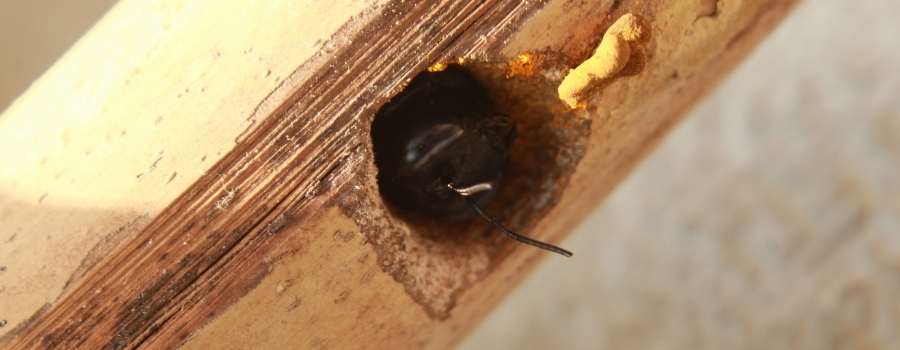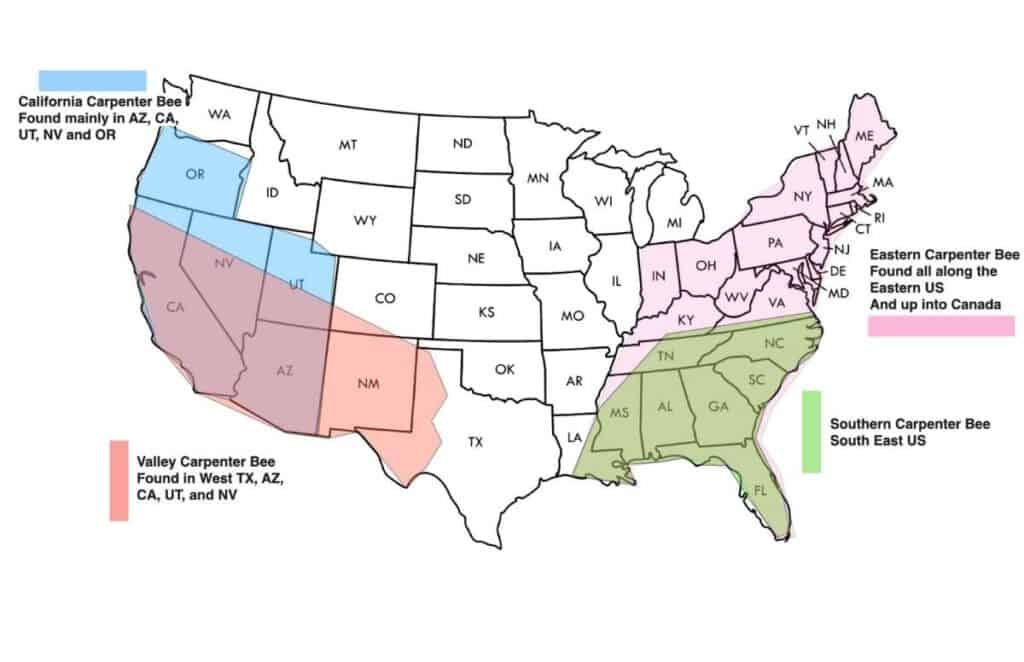
Carpenter bees, sometimes referred to as “white-footed” or “toothed” bees, are one of the most common types of bees found in North America. They look similar to bumblebees but lack the fuzzy hair characteristic of their cousins. Like other bee species, carpenter bees live in hives and colonies with a single queen bee who lays eggs.
While carpenter bees don’t pose a great threat to people, they are a nuisance due to the fact that they bore holes into the wood of your house, porch, or fences.
Like other bee species, carpenter bees do offer some good benefits to your yard and community so you’ll want to deter them from your home rather than eradicating them.
What Is A Carpenter Bee?
Carpenter Bees are a non-honey-producing bee that is found all over the United States. In spite of their inability to produce honey, they serve as terrific pollinators for fruiting plants like eggplants and tomatoes, increasing both the yield and size of the fruit.
Carpenter Bees aren’t aggressive and only females are capable of stinging, though this is incredibly rare and only if they are being harassed. The biggest annoyance of Carpenter Bees is that they will boreholes in soft, non-treated wood such as fencing, roof eaves, and siding. This is easily remedied by painting or staining the wood.
What Are Some Characteristics of a Carpenter Bee?
Typically, Carpenter Bees have shiny, smooth abdomens while Bumblebees are covered in thick hair. Because of this, Carpenter Bees are sometimes called “shiny Bumblebees” or “smooth-tailed” bees.
Carpenter Bees have bright yellow and black markings with the majority being entirely black except for bands of color around their abdomen. Males tend to be shinier than females but both can vary in tone from dark
Carpenter Bees are a large species of bee found all over the United States. They are solitary critters and don’t live or work in a hive system like most other bees. Instead, they will burrow a hole into softwood where they’ll live with a mate and lay their eggs.
What Parts of North America Do Carpenter Bees Live In?
The various species of Carpenter Bees can be found all over North America with cousins being found all over the world. The map below shows where the four main species of Carpenter Bees are located in the U.S. Of course, bees don’t follow border rules, so they may roam into surrounding areas.

Do Carpenter Bees Sting or Bite?
Male carpenter bees don’t have stingers or large enough mandibles to be harmful to people and pets. Females do have stingers but will only use them if they are directly handled or harassed.
Males may seem aggressive due to their large size and quick, swooping patterns when they fly that sometimes comes close to you. They do this to chase off other flying insects that wander too close to their territory but pose no threat to people or pets.
Carpenter Bees are non-aggressive solitary creatures who only sting if directly handled or harassed. They typically don’t fly far from their nest and won’t attack people, but if they do sting it is incredibly rare and usually only happens during nesting season when the bees are stressed. Make sure to contact a professional exterminator if you spot one of these creatures on your property as their usual behavior means that their presence is a sign of an infestation.
Are Carpenter Bees Good For Plants And Gardens?
Like other species of bees, Carpenters Bees are great pollinators. What’s special about Carpenters is that they pollinate using a method called “buzz” pollination. This means they vibrate their bodies to dislodge pollen from the flower, something honey bees don’t do.
Fruit-bearing plants like tomatoes, blueberries, and eggplants will produce bigger fruit and larger quantities thanks to buzz pollination.
Thanks to their large size and generally harmless nature, Carpenter Bees attract several bird species and mammals that like to feed on them. In areas where Carpenters are abundant, you can expect there to be Woodpeckers and Shrikes.
What Problems Do Carpenter Bees Pose?
In general, Carpenter Bees are only harmful to the wood that makes up your home, porch, and fences. While they don’t eat wood, they like to bore out holes to use as nests. Carpenter Bees like soft, untreated, or unpainted wood that they can quickly bore into and lay their eggs.
You don’t have to worry about these holes gradually growing in size and forming into a large hive or colony like with other bees or wasps. Carpenter Bees are solitary…often living alone or with a mate and like to keep their territory void of other Carpenter Bees.
However, other Carpenter Bees will find other areas around your home and create their own nests. If left untreated, you could end up with thousands of nesting holes around your home or property.
Unfortunately, they don’t always bore nest holes in easy-to-reach, convenient areas. They like untreated, dried-out wood so they will often use the underside of porch railings, eaves of the house, or the underside of raised sheds and garages.

How Do You Know If Carpenter Bees Are Infesting Your Home?
Aside from seeing them hanging out near porches and bushes, or from having them dive-bomb your head on occasion, here are some tell-tale signs that Carpenter Bees have moved in making themselves at home.
- Check for holes in older or unfinished wood near or in your house
- If you can’t see directly into cramped areas, look for small piles of sawdust or wood pieces
- Their feces will leave yellow stains, usually near holes they’ve made
- If you notice more of them chasing each other. Carpenter Bees are solitary and will chase each other away from their territory.
Potential Areas to Check
Carpenter Bees like untreated wood, the dryer and more weathered the better. Some areas to keep an eye on are:
- Windowsills
- Porches
- Sheds
- Garages
- Fences
- Lawn Furniture
- Doors
They may also be attracted to old wood piles or rotted-out tree trunks. If you live in a heavily wooded area, then you may want to walk your property line and look for these culprits.
What’s The Best Way To Get Rid Of Carpenter Bees?
Typically, the best way to rid your home of Carpenter Bees is by calling in a professional. Other ways include making sure you keep all wood surfaces around your home sealed and treated or install bird feeders to attract natural carpenter bee predators.
If left untreated, Carpenter Bees can cause serious damage to unprotected wood like your home or lawn furniture and even wooden fences. If not treated, it can lead to large nests that house thousands of bees.
As I mentioned earlier, their nesting behavior is solitary and territorial so removing the wrong nest could result in a bee fight with potentially dangerous results.
There are several methods for getting rid of these pesky pollinators…ideally, you’ll want to use non-lethal ones, but if all else fails you might have to get more aggressive, here are a few to look into:
- Bee Traps – These work best indoors or on structures like sheds. They’re not ideal for open areas like porches or patios where the bees are active and easily disturbed.
- Chemical Treatments – You apply a thick liquid insecticide directly into each nest hole which is then sealed with caulk, wood putty or silicone sealant to keep it from spilling out onto your property. This treatment lasts for several months until rain washes away the chemicals rendering them useless. The downside is they can be hazardous to your health and any other animals or children that come in contact with the chemicals.
- Citrus Spray – Using a citrus spray (or almond extract spray) is a slightly more aggressive, but still non-lethal, way to get rid of those little buggers. Many insects, Bees included, are driven away by natural citrus oils like orange, lemon, lime, and grapefruits. Mix some citrus extract and water into a spray bottle and spray any areas that have signs of Carpenter Bee activity.
This method will drive the Bees away without harming them and will keep them away longer as the citrus oils penetrate the wood. Periodically go around and monitor areas and re-spray as needed and, better yet, put some sort of wood sealer or treatment on untreated wood to further deter Carpenter Bees from returning. - Pesticides – Spraying a pesticide is another treatment which will last for up to several months depending on the strength of the insecticide used. It works best when you spray both sides of each nesting hole after it’s been sealed. The most aggressive method, but likely the most effective, is to use some sort of pesticide.
In the spring, when Carpenter Bees are looking to hunker down and lay eggs, look for areas they are starting to bore holes. In these areas, for a 2-3 weeks period, spray a pesticide like Demon WP or Fenvastar Cap. The downside of this method could be potentially harming other animals you don’t intend to, like Honey Bees. Since Carpenter Bees do serve an important service in the pollination of plant life, this method should be a last resort and only if you have an infestation. - Use Noise and Vibration – Carpenter Bees don’t like noise. One method in getting rid of them, though it may or may not be practical, is to play loud music and/or noises for 2 to 3 days. The upside to the noise method is that it’s by far the most non-lethal method. It also has virtually zero cost associated with it since most everyone has an old boom box or set of speakers laying around that they can set up for the task.
The downsides are kind of obvious. If you live in a condo complex or crowded cul-de-sac, the bees might not be the only residents annoyed by your actions. It’s probably best to let you neighbors know what’s going on and try to get them on board. This method might not last very long either. After a few days or weeks, the Carpenter Bees may settle back in and you’ll be back to square one.

What’s The Best Way To Prevent Carpenter Bees?
In general, you want to rid your home and property of the ideal environment for Carpenter Bees. If you have any old, dried, untreated wood then make sure you apply fresh coats of paint or sealant. You can also apply a wood preservative to the wood.
If you have an old deck or shed, make sure it’s in good shape and free of any rotting lumber. This is where Carpenter Bees typically live so if there are any holes or cracks they will take advantage of that. Keep shrubbery trimmed back from the side of your
After driving the bees away, or…as a last resort…killing them, apply some insecticide dust like Tempo Dust and make sure to seal up any holes they may have made. This will seal in any eggs they may have laid and kill them before they hatch. This will also prevent a new Carpenter Bee from moving into the newly vacated hole.
After sealing any holes, stain or paint, and non-treated wood. It may also be a good idea to periodically spray the area with a non-lethal spray, like the citrus oil-water mixture mentioned above, just to keep any potential problems at bay.
Final Thoughts
They’re big, they dart around and seem menacing, but Carpenter Bees do serve a good purpose for the environment. They are pollinating powerhouses and a great source of food for birds and mammals.
Unless they are truly becoming an infestation, I would caution against using lethal pesticides and instead try driving them away using other methods. I would also caution against using a pesticide that is harmful to Honey Bees or other beneficial insects.
If you have an infestation, however, I wouldn’t hesitate to call in a professional…they’ll know exactly how to handle bulk insects, get into areas that you’d likely never think of, and most of the time will offer some sort of a warranty or limited service guarantee.
